ROME (ViaNews) - The FIA Smart Cities Forum is an initiative which aims to bring awareness on the future of urban mobility, discussing on the new policies, challenges, and technologies which allow making the transition to more efficient and environmentally friendly solutions to the inhabitants of cities all over the world.

The Italian host
The last and final venue of the year took place in Rome. The Italian city capital has an estimated population of more than 4 million inhabitants, and since last year has been implementing its own Sustainable Urban Mobility Plan (SUMP).

A view of the traffic at Piazza della Republica in Rome. Photo by Cecilia Demartini.
Rome is a member of the CIVITAS initiative launched by the European Commission back in 2002. The cities´ network works towards a cleaner, and better transport in 10 main areas including Clean Fuels & Vehicles, Collective Passenger Transport, Mobility Management, and Urban Freight Logistics.
The Roman Forum revealed the initiatives that the Italian city is taking towards sustainable mobility within its city center along with a global scale view of how urban mobility is and will continue to change the lives of the inhabitants in the upcoming years.

Enel electric vehicle fast charging station in Rome. Photo by Cecilia Demartini.
How is Rome changing its urban mobility landscape?
The Roman city is increasing the number of hybrid buses, by refurbishing old buses which were not at use and bringing them back to the streets as Trolley Buses.

The use of shared mobility services is increasing, it is also easy to see electric bikes and scooter all over the streets of the Eternal city.
Rome has also announced its plan to ban diesel cars from the historical city center by 2024, a goal that will start to give its first steps this November 2019 in a large area of the city in order to reduce the pollution levels and improve the quality of life for its residents.

Share'n go electric car in Rome. Photo by Cecilia Demartini.
According to CIVITAS, 80 km of new bike lanes are being built, future two-wheel milestones are reaching a five percent modal share for cycling, which is estimated to happen by 2022, as the completion of a 45km-long circular cycle path named “Grab” that extends out from the city center to the edge of the city. The introduction of the 30 km/h speed limit in several areas is also among the initiatives to be introduced.

Electric Cars in Rome. Photo by Cecilia Demartini.
Rome, smart cities, and Formula E - The electric future
The city welcomed the Forum, for the second year in a row, at the Museo Nazionale dell´Alto Medioevo, sited in the EUR neighboorhood.
Museo Nazionale (FIA Smart Cities Forum in Rome). Photo by Cecilia Demartini.
The venue was preceded by two other events in 2019, one celebrated in Mexico City and another in the Chinese city of Hong Kong, both are large cities with mobility and environmental issues.
"Finding the right innovative solution" panel at FIA Smart Cities Forum in Rome. Photo by Cecilia Demartini.
The venue held the day before to the all-electric racing series (Formula E) Rome E-Prix, presented a series of discussion panels in which global entrepreneurs, as well as European authorities, took part as speakers to talk about the initiatives that can affect the lives of the inhabitants and the dynamic of city centers in a way that improves its daily life as well as the environment they live in.
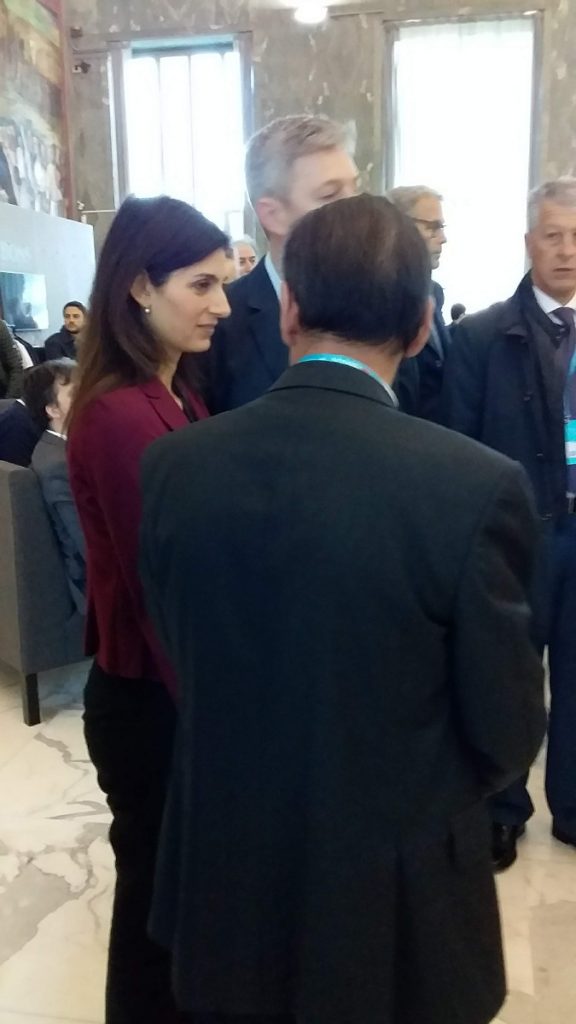
Virginia Raggi, Mayor of Rome, at FIA Smart Cities Forum in Rome. Photo by Cecilia Demartini.
Among the speakers were Virginia Raggi, Mayor of Rome, Philippe Close, Mayor of Brussels, Alejandro Agag, Founder and CEO of Formula E Holdings, and Timothy Papandreou, Founder of Emerging Transport Advisors.
Alejandro Agag, Founder, and CEO of Formula E Holdings who opened the ceremony highlighted how the event is a perfect complement to a Formula E race weekend.
"Since the beginning when we started thinking about this championship together with the FIA, we were convinced that what we wanted to bring to a city, it was not only a race. I think race is the excuse for everything else that we build around it and that is what really brings value.
We created Formula E to create change and you do that by changing the minds and the perception of the people about mobility, in this case, electric cars, to do that you need this kind of Forums to amplify the message."
When asked about what's next for 2020, the Spaniard showed his enthusiasm, saying that he cannot wait for the next season of Formula E when German car manufacturers Mercedes and Porsche joining the series.
"This championship (referring to Formula E) has become the home of all these car manufacturers (talking about the major brands in the car industry) that will be the key drivers of the revolution, because without the big car manufacturers we will not be able to change all the cars that are in the streets polluting the cities, we need the big car manufacturers to help make the change."
Agag made clear the vision of Formula E on urban mobility and also explained how the technology used in the all-electric series transfers to the cars on the roads.
"Being in the heart of the cities is the key part of the DNA of Formula E. The electric revolution needs to start in the cities, electric cars are ideal for the distances that you drive in cities every day. The cities are where pollution from mobility affects people more because people live in the cities.
First, you have to have to take the pollution out, then you have to eliminate the pollution of generating power by generating solar energy and with clean resources.
There are problems all over the planet (referring to the environment) and electric mobility can help in the cities and also outside the cities."
On technology transfer from the racing cars to the roads worldwide
"Battery management, technology software development are key areas that have a very quick transfer from racing to road. There is battery cooling, for example, battery temperature is a really important element of electric car technology. All those things are being tested in this laboratory that is Formula E and then applied to the road cars."
BMW electric car used as Safety Car in Formula E at FIA Smart Cities Forum in Rome. Photo by Cecilia Demartini.
With over two-thirds of the overall population estimated to be leaving in cities in a time frame of twenty years, Mayors play a key role in the future on a sustainable mobility urban development.
The first European authority set to speak on the discussion topic, Policies for the Cities of the Future, was the recently re-elected Mayor of Brussels, Philippe Close who shared his perspective on the Future of Mobility.
"Brussels is one of the most cosmopolitan cities of the world, what we try to do, is to find solutions not only for the traffic congestion but also to move the people, that is the goal of all the cities in the world."
"For me, the XXIst century is the century of exchange and experience. I think with the different Mayors of the world we can exchange about Mobility because we all face the same problems,” Close added.
All the attention was then focused on Virginia Raggi, Mayor of Rome.
The first woman to be elected as Mayor in the Roman city shared her perspective with the audience present at the Museo Nazionale dell´Alto Medioevo.
Virginia Raggi, Mayor of Rome, speaking at FIA Smart Cities Forum in Rome. Photo by Cecilia Demartini.
“All of us here have a vision, and today, with events such as Formula E, we can touch this vision because we can show it’s real and possible. Many citizens are still not very comfortable with this. We have to tell them ‘Get out of your comfort and just go explore what technology is doing now.’ It’s all about changing minds and changing habits.”
Raggi who is the Mayor of Rome since 2016 left the room as she arrived, followed by the local media.
Urban revolution
Timothy Papandreou, Founder of Emerging Transport Advisors talked about the solutions to the transition to shared, electric and automated mobility and his experience with cities.
ABB charging station at FIA Smart Cities Forum in Rome. Photo by Cecilia Demartini.
“More and more people are moving to cities and there’s physically no way we can move everybody around in the future if everybody has their own car, it´s just physically not possible, it´s a geometry math issue,” he said.
To open the discussion on how cities are preparing for the Urban Revolution, the Chief´s Innovation Officer for San Francisco´s agency raised the question, what is the government role of cities on this global change?
Papandreou highlighted the three trends that in his view can help solve many issues within the cities of the world.
The idea of sharing a vehicle whichever it is a scooter, a bike, a bus or a car, the idea of electrifying the system and the idea of autonomous vehicles.

Regarding infrastructure and technology, he added: "If we design our streets just to moving cars, we shouldn´t be surprised that we have a lot of congestion and traffic, if we design our streets to move people, we´ll see people change behavior, technology can help us do these things."
He also pointed out that transport systems should be safe, a system that everybody can use, available and affordable to citizens, and shared interesting facts.
"Everybody that moves around every day takes about 1sq meter of space if you are in a bicycle or a scooter you need 2sq meters, but when you are in a car you need 8 square meters of space," Papandreou added.
The second discussion panel of the day, "Finding the Right Innovative Solution", was moderated by Timothy Papandreou.
Among the speakers was Radek Jelinek who joined the German multinational automotive corporation Daimler in 1987 and since October 2018 has become President and CEO of Mercedes-Benz Italia.
"We are the oldest car company in the world but we´ve been always very innovative, now we´re guiding to the next level of innovation."
Jelinek highlighted the importance of what he defined as a "smart transition" from combustion engines to electric cars, advising not to rush into the switch as combustion engines are still very important to transportation.
"The future is a little bit uncertain, but I think electric is a good guess as long as also we get the electricity from environmentally clean production. The whole 360 view is very important from our perspective."
The Executive also noticed "People are still going to be crucial for any development, we need people talking to other people."

